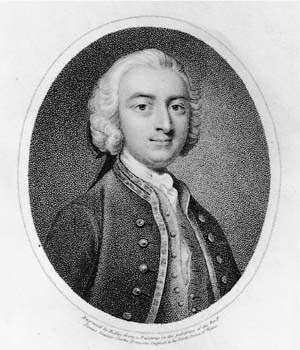Sir John Moore, 1st Baronet facts for kids
Quick facts for kids
Sir
John Moore
|
|
|---|---|
 |
|
| Born | 24 March 1718 |
| Died | 2 February 1779 (aged 60) |
| Allegiance | |
| Service/ |
|
| Years of service | 1729–1779 |
| Rank | Admiral |
| Commands held | HMS Terror HMS Ferret HMS Squirrel HMS Diamond HMS Dolphin HMS Deptford HMS Duke HMS Devonshire HMS St Albans HMS Monarch HMY William & Mary Leeward Islands Station Downs Station Portsmouth Command |
| Battles/wars | |
| Awards | Baronet Knight of the Bath |
Sir John Moore (born March 24, 1718 – died February 2, 1779) was a brave British officer in the Royal Navy. He served during two big wars: the War of the Austrian Succession and the Seven Years' War. He started his naval career very young and worked his way up to become an admiral.
Contents
John Moore was born on March 24, 1718. He was the third son of Henry Moore, who was a church leader in Malpas, Cheshire. His mother, Catherine, was the daughter of Sir Thomas Knatchbull.
John first went to school at the Whitchurch grammar school. But by the age of 11, he joined the navy. He was listed on the ship HMS Lion in 1729. This ship was sailing to the West Indies. Lion was the main ship for Rear-Admiral Charles Stewart, who was a relative of John's.
Starting His Sea Adventures
Before Lion sailed, John moved to other ships. First, he went to HMS Rupert, then to HMS Diamond. In 1731, George Anson became the commander of Diamond. John spent a year on Diamond.
After that, he moved to HMS Princess Amelia. Then he joined HMS Squirrel, which was also commanded by George Anson. John spent three and a half years on Squirrel near Carolina. He later served on other ships like HMS Edinburgh and HMS Torrington.
On April 6, 1738, John passed his test to become a lieutenant. He then joined HMS Lancaster. This ship was part of a fleet patrolling near Cadiz and in the Mediterranean Sea.
Rising Through the Ranks
In 1742, John Moore was moved to the flagship HMS Namur. Later, he returned to England. He had important relatives who helped him get new jobs and promotions. On December 24, 1743, he was given command of a new frigate called HMS Diamond.
In May 1744, he sailed with Diamond to the East Indies. His squadron captured two French ships. One was a rich merchant ship, and the other was a large privateer (a private ship allowed to attack enemy ships). The privateer was then used by the British navy.
After his commander died, John returned to England in 1746.
Serving with Admiral Hawke
In 1747, John Moore was given command of HMS Devonshire. This ship was the main ship for Rear-Admiral Edward Hawke. John was with Hawke during a major sea battle called the Second Battle of Cape Finisterre on October 14, 1747. In this battle, Hawke's fleet defeated a French fleet.
John Moore did very well in the battle. Hawke trusted him to deliver the important news of the victory back to Britain. Hawke even wrote that John "signalized himself greatly in the action," meaning he performed exceptionally well.
After the war, during a time of peace, John commanded the royal yacht HMY William & Mary. He later returned to command Devonshire in 1756.
The Seven Years' War
In January 1757, John Moore was part of a special court that judged Admiral John Byng. Later, he asked to be released from his promise of secrecy about the trial.
In 1758, John was made a commodore. This meant he was in charge of a group of ships. He became the commander-in-chief of the Leeward Islands Station. He raised his flag on HMS Cambridge.
Attacks in the West Indies
In January 1759, John Moore received more ships and soldiers. He was ordered to attack French areas in the West Indies. He led his force from Barbados to Martinique. They captured Fort Negro and helped land troops. However, the attack on Martinique was stopped because the general worried about hidden traps.
John then suggested attacking Guadeloupe instead. For the Invasion of Guadeloupe, he moved his flag to HMS Woolwich. The fleet arrived on January 22. On January 23, his ships attacked the main fort. The attack lasted for hours, silencing the defenses and causing fires.
British troops landed and pushed the French into the hills. The French continued to fight from there. John heard that a large French navy force was coming. He moved his ships to a better position to stop them. No attack came, and Guadeloupe surrendered to the British. After this success, John Moore returned to England in 1760.
Later Years and Legacy
John Moore was promoted to rear-admiral on October 21, 1762. He spent the rest of the war as the commander-in-chief in The Downs. He then became the commander-in-chief at Portsmouth, a job he held for three years.
He was given the special title of baronet on March 4, 1766. He continued to receive promotions based on his long service. He became vice-admiral on October 18, 1770. In 1772, he was made a Knight of the Bath. Finally, he became a full admiral on January 29, 1778.
John Moore had suffered from a painful condition called gout since the 1760s. His health slowly got worse. His last public act was to join his old commander, Edward Hawke, in signing a protest. This protest was against a court-martial (a military trial) for Admiral Augustus Keppel in December 1778.
John Moore passed away two months later, on February 2, 1779.
Family Life
John Moore married Penelope, the daughter of General William Matthew, around 1756. They had one son who died young, and four daughters. When John Moore died, his special title of baronet ended because he had no surviving son to inherit it.



